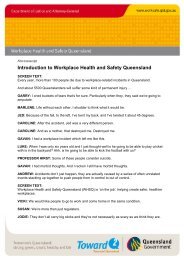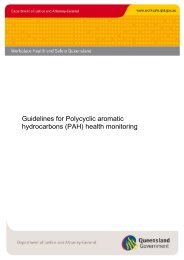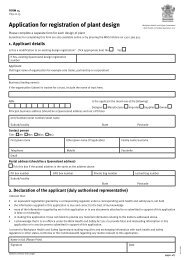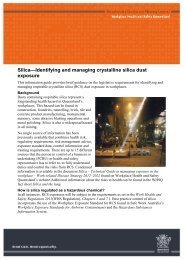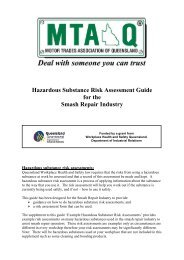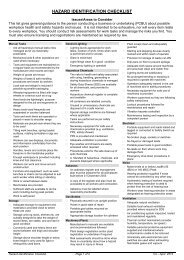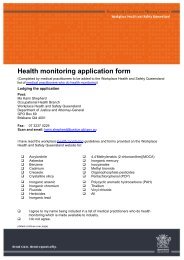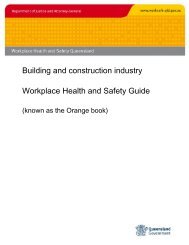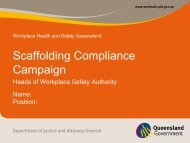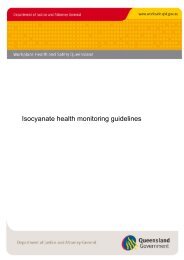Personal hearing protectors - Queensland Government
Personal hearing protectors - Queensland Government
Personal hearing protectors - Queensland Government
You also want an ePaper? Increase the reach of your titles
YUMPU automatically turns print PDFs into web optimized ePapers that Google loves.
<strong>Personal</strong> <strong>hearing</strong> <strong>protectors</strong> – Protecting your <strong>hearing</strong>In most industries there are instances where wehave to resort to using personal <strong>hearing</strong><strong>protectors</strong> such as earmuffs or earplugs. To usepersonal <strong>hearing</strong> <strong>protectors</strong> correctly andeffectively a number of factors must beconsidered.How do we hear and why does our<strong>hearing</strong> need protection?Figure 1: Brief description of how we hear(Courtesy of EAR Cabot Safety Corporation)Exposure to loud noise at work (but also athome or during leisure activities) can destroy thetiny hair cells in our inner ears. When they aredamaged <strong>hearing</strong> is lost, as messages can nolonger be sent to our brain to interpret thesounds. Hearing loss is permanent as there isno cure. Hearing loss affects not only your ownquality of life, but also that of everyone else youdeal with. It is important to protect your <strong>hearing</strong>,especially at work.How to go about protecting your<strong>hearing</strong>?The Noise Code of Practice 2004 states thatpersonal <strong>hearing</strong> <strong>protectors</strong> should not be usedas a substitute for engineering or administrativenoise control measures. Hearing <strong>protectors</strong>should be regarded as an interim measure whilereduction of noise exposure is being achievedby other control measures. This is in line withthe obligation to manage risks under theWorkplace Health and Safety Act 1995 (Section27A) requiring that risk assessments are carriedout and appropriate control measures put inplace to minimise or prevent the risk. To putappropriate control options in place for identifiedrisks we need to follow the hierarchy of controlsand explore and implement higher ordercontrols, where reasonably possible andpracticable, before settling for lower ordercontrols.In many industries there are possibilities forengineering controls for a range of plant andequipment. The Health and Safety Executive’swebsite (United Kingdom) may provide someuseful information for your situation:http://www.hse.gov.uk/noise/casestudies/csindex.htm.Some obvious examples are compressors,silencers on air exhausts and acoustic hoods onmulti-spindle planers. Where engineeringcontrols are not possible administrative controlsshould be investigated or it may be that personal<strong>hearing</strong> <strong>protectors</strong> have to be worn.When inserting earplugs clean hands arenecessary to avoid infections of the ear canal.Dirt from your fingers is transferred onto the plugwhen rolling the earplug tight before inserting itinto our ears and so may cause ear infections.
Earmuffs provide a less critical fit over our earsthan earplugs do in our ears, and are less likelyto cause ear infections.Another form of <strong>hearing</strong> protector is the socalledear canal cap. It consists of pods oneither end of a plastic tension band. The podsblock the entrances of our ear canals rather thanbeing inserted. They are easily put in place andremoved when not needed. AS/NZS 1270 testsindicate a reduction of about 20 to 22 dB couldbe obtained from ear canal caps when worncorrectly.exposed to noise, its effectiveness is drasticallyreduced as you can see in Figure 3 below. If the<strong>hearing</strong> protector rated at 28 dB is not worn for10 minutes in noise during an 8-hour shift itsattenuation is reduced to only 16 dB making theeffective protective value 12 dB less than youexpected and may result in risk of <strong>hearing</strong> lossdue to insufficient protection.Figure 2: Typical example of an earmuff collectingdustThe problem with <strong>hearing</strong> <strong>protectors</strong> in the realworld is that they are either of the wrong rating,not used at all, act as dust collectors, as shownin Figure 2, or are used infrequently and sodrastically reduce their effectiveness toinsufficient levels.Hearing <strong>protectors</strong> are often selected on thebasis that the higher the protection rating thebetter they protect, and consequently in manyindustrial situations they over-protect. Overprotectionhinders communication betweenworkers and the ability to hear machinesoperating correctly or give the wearer a feelingof isolation from the work environment.In noisy work environments you can often seeworkers lift a cup of an earmuff or pull out theirearplugs during conversations. If you do notwear your protector the whole time you areFigure 3: Reducing effectiveness of <strong>hearing</strong><strong>protectors</strong> with time not worn.Studies Berger (2000), Eden and Piesse (1991)demonstrate that the ‘real-world’ protection fromearmuffs and plugs may be up to 6 dB lower formuffs and up to 9 dB lower for plugs when usedin the work situation. In the example of Figure 3,this means that the effective rating may be only10 dB if earmuffs were worn and 7 dB ifearplugs were worn.More informationFurther information is available fromwww.worksafe.qld.gov.au or by calling the WHSInfoline on 1300 369 915.© The State of <strong>Queensland</strong> (Department of Justice and Attorney-General) 2011Copyright protects this document. The State of <strong>Queensland</strong> has no objection to this material being reproduced, but asserts its right to be recognised as author of theoriginal material and the right to have the material unaltered.The material presented in this publication is distributed by the <strong>Queensland</strong> <strong>Government</strong> as an information source only. The State of <strong>Queensland</strong> makes nostatements, representations, or warranties about the accuracy or completeness of the information contained in this publication, and the reader should not rely on it.The <strong>Queensland</strong> <strong>Government</strong> disclaims all responsibility and all liability (including, without limitation, liability in negligence) for all expenses, losses, damages andcosts you might incur as a result of the information being inaccurate or incomplete in any way, and for any reason.Workplace Health and Safety <strong>Queensland</strong> Department of Justice and Attorney-GeneralInformation Sheet – <strong>Personal</strong> <strong>hearing</strong> <strong>protectors</strong> – Protecting your <strong>hearing</strong>PN10134 Version 1. Last updated July 2009.




